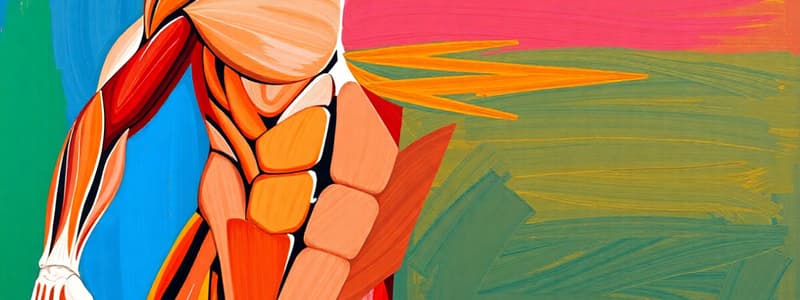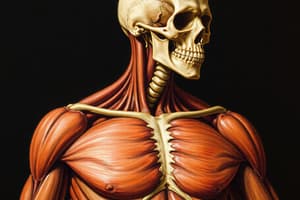Podcast
Questions and Answers
What is the primary function of muscle tissue?
What is the primary function of muscle tissue?
- To produce energy for the body
- To connect bones to other bones
- To produce movement through contraction (correct)
- To provide insulation for organs
Which type of muscle is responsible for involuntary movements in hollow organs?
Which type of muscle is responsible for involuntary movements in hollow organs?
- Smooth muscle (correct)
- Skeletal muscle
- Cardiac muscle
- Voluntary muscle
What initiates the contraction of skeletal muscles?
What initiates the contraction of skeletal muscles?
- Electric impulses from the heart
- Neurotransmitter release at the neuromuscular junction (correct)
- Hormones secreted by glands
- Stretching of muscle fibers
Which proteins interact in muscle cells to facilitate contraction?
Which proteins interact in muscle cells to facilitate contraction?
What role do skeletal muscles play in the body beyond movement?
What role do skeletal muscles play in the body beyond movement?
What is the primary function of acetylcholine (ACh) in the body?
What is the primary function of acetylcholine (ACh) in the body?
What characterizes an agonist in muscular movement?
What characterizes an agonist in muscular movement?
Which type of muscle is responsible for involuntary movements in the heart?
Which type of muscle is responsible for involuntary movements in the heart?
What is the role of creatine kinase (CK) in muscle tissue?
What is the role of creatine kinase (CK) in muscle tissue?
Which disorder is characterized by widespread muscular aches and stiffness without a known cause?
Which disorder is characterized by widespread muscular aches and stiffness without a known cause?
What is the primary characteristic of myasthenia gravis (MG)?
What is the primary characteristic of myasthenia gravis (MG)?
What is the term for involuntary small contractions or twitching of muscle fiber groups?
What is the term for involuntary small contractions or twitching of muscle fiber groups?
Which type of agent reduces inflammation and can include steroids?
Which type of agent reduces inflammation and can include steroids?
What is the primary function of physical therapy (PT)?
What is the primary function of physical therapy (PT)?
Flashcards
Muscle Contraction
Muscle Contraction
The ability of muscle tissue to shorten and produce movement.
Smooth Muscle
Smooth Muscle
A type of muscle tissue found in the walls of hollow organs like the stomach and blood vessels.
Cardiac Muscle
Cardiac Muscle
The type of muscle tissue that makes up the heart, responsible for pumping blood.
Skeletal Muscle
Skeletal Muscle
Signup and view all the flashcards
Acetylcholine (ACh)
Acetylcholine (ACh)
Signup and view all the flashcards
Acetylcholine
Acetylcholine
Signup and view all the flashcards
Neuromuscular Junction (NMJ)
Neuromuscular Junction (NMJ)
Signup and view all the flashcards
Actin
Actin
Signup and view all the flashcards
Myosin
Myosin
Signup and view all the flashcards
Tendinitis
Tendinitis
Signup and view all the flashcards
Myasthenia Gravis (MG)
Myasthenia Gravis (MG)
Signup and view all the flashcards
Tetanus
Tetanus
Signup and view all the flashcards
Study Notes
Muscular System Overview
- The muscular system's core function is contraction, enabling movement of skeletal structures, internal organs, blood vessels.
- Muscles maintain posture through partial contraction.
Types of Muscles
- Smooth muscle: Found in hollow organs (stomach, intestines, blood vessels), responsible for involuntary peristalsis (wave-like movements).
- Cardiac muscle: Forms the heart wall (myocardium), responsible for involuntary pumping action.
- Skeletal muscle: Attached to bones, responsible for voluntary movement, posture maintenance, and heat generation. Skeletal muscles together create the muscular system.
Skeletal Muscle Structure
- Skeletal muscle is comprised of individual cells called fibers, bundled together in fascicles.
- These fascicles are surrounded by connective tissue (epimysium, perimysium), which merge to form tendons that attach the muscles to bones.
- Muscle fibers contain myosin and actin filaments, crucial for contraction.
- Neurotransmitters, like acetylcholine (ACh), initiate muscle contraction at the neuromuscular junction (NMJ).
Skeletal Muscle Contraction
- Motor neurons stimulate skeletal muscles at the neuromuscular junction (NMJ).
- ACh is released, binding to muscle cell membranes to trigger contraction.
- Myosin and actin filaments interact to cause contraction. ATP (adenosine triphosphate) and calcium are necessary for this process.
Muscular System Terminology
- Agonist: The muscle performing a particular movement
- Antagonist: The muscle opposing the movement of the agonist.
- Fascia: Connective tissue sheath covering muscles.
- Fascicle: A bundle of muscle fibers.
- Neuromuscular Junction (NMJ): Where motor neuron branches connect with a muscle cell.
- Acetylcholine (ACh): A neurotransmitter critical to initiating muscle contraction.
- Actin & Myosin: Protein filaments essential for muscle contraction.
Muscular System Roots
- My/o: Muscle
- Muscul/o: Muscle
- In/o: Fibre
- Fasci/o: Fascia
- Ten/o, Tendin/o: Tendon
- Ton/o: Tone
- Erg/o: Work
- Kin/o-, Kine, Kinesi/o, Kinet/o: Movement
Disorders of the Muscular System
- Dermatomyositis: Inflammation of muscles and skin.
- Fibromyalgia Syndrome (FMS): Widespread muscle pain and stiffness without known cause.
- Muscular Dystrophy: Group of hereditary muscular diseases resulting in progressive weakness and atrophy.
- Myasthenia Gravis (MG): Autoimmune disease causing weakness & fatigue in muscles.
- Polymyositis: Inflammation of multiple muscles.
- Tendinitis: Inflammation of tendons, usually due to injury.
- Ataxia: Lack of muscle coordination
- Fasciculation: Involuntary muscle twitching.
- Fibrositis: Inflammation of fibrous connective tissue, affecting muscles.
- Rhabdomyolysis: Acute muscle destruction.
- Rhabdomyoma: Benign skeletal muscle tumor.
- Tetanus: Severe muscle spasms caused by bacterial infection.
- Tetany: Muscle spasms or cramps caused by metabolic imbalance (low calcium).
Diagnosis and Management
- Creatine Kinase (CK): Enzyme elevated in muscle damage.
- Electromyography (EMG): Measures electrical activity in muscles.
- Physical Therapy (PT): Improves movement, mobility and rehabilitation.
- Rheumatology: Study and treatment of rheumatic diseases.
Drugs for Muscular System
- Anti-inflammatory agents: Reduce inflammation (steroids, NSAIDs).
- COX-2 inhibitors: NSAIDs that target a specific enzyme.
- Muscle relaxants: Reduce muscle tension.
- Nonsteroidal anti-inflammatory drugs (NSAIDs): Reduces inflammation.
Studying That Suits You
Use AI to generate personalized quizzes and flashcards to suit your learning preferences.




